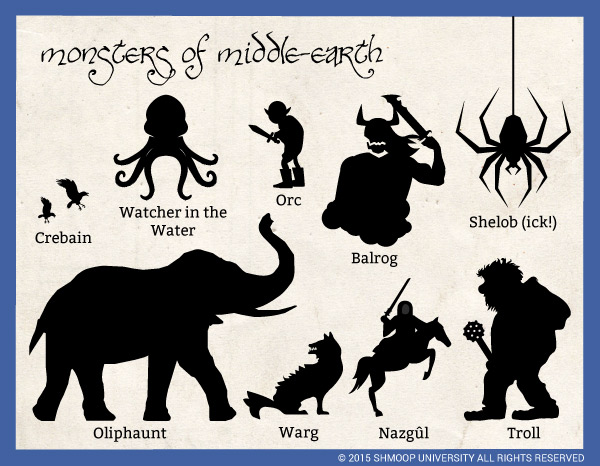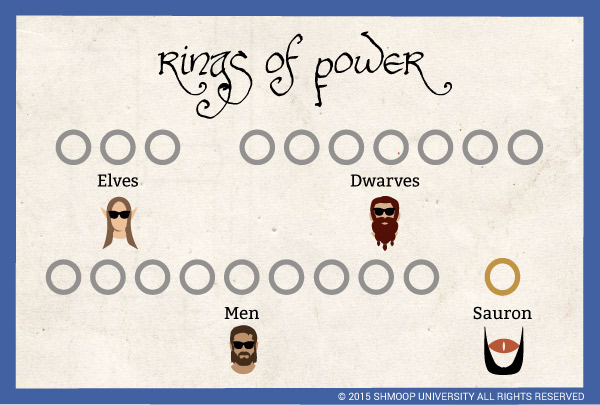Character Analysis
Balin, Ori, and Óin
These three Dwarves are surviving members of Bilbo's original expedition to the Lonely Mountain in The Hobbit. It is because of them that Glóin has come to Rivendell to be part of the Council of Elrond. In the Mines of Moria, the Company discovers what has become of them: Balin, Lord of Moria, died in Dimrill Dale when an Orc shot him from behind a stone as he stood looking in the Mirrowmere. The Watcher in the Water – the snaky, tentacled thing at the western gate of Moria – killed Óin. And Ori's fate is unknown, but as he is the one who wrote the chronicle of the deaths of the other two and his last sentences are, "We cannot get out. The end comes [...] they are coming" (2.5.11), we are pretty sure he died in Moria.

(Click the infographic to download.)
Dáin
Dáin is King Under the Mountain, the Dwarf lord of the Lonely Mountain stronghold. He became King Under the Mountain with the death of Thorín Oakenshield at the end of The Hobbit. He is over 250 years old, "venerable, and fabulously rich" (2.1.101). Dáin is also a just man: when messengers came from Sauron offering the Dwarvish rings of power back in exchange for the One Ring carried by a Hobbit of Dáin's acquaintance (i.e., Bilbo), Dáin sends Glóin to Rivendell to warn Bilbo "that he is sought by the Enemy, and to learn, if may be, why he desires this ring" (2.2.24).

(Click the infographic to download.)
Durin Lord of Moria
The great ancestor of the Dwarves; it was he who delved the Mines of Moria and built the Dwarf city of Khazad-dûm. On the door to Moria appears his symbol: a hammer and anvil surmounted by a crown with seven stars. But Durin's people dug too deep in Moria, awakening an ancient evil that is now called Durin's Bane. Since the day of Durin VI (not the first Durin, but a descendant) Moria has not been safe for people to travel. When Gandalf and Company have reached a huge, empty hall high up in the Mines, Gimli is moved to sing a song about Moria. Gimli sings that darkness has fallen on Khazad-dûm, but "still the sunken stars appear/ In dark and windless Mirrormere;/ There lies his crown in water deep,/ Till Durin wakes again from sleep" (2.4.180). So the Dwarves believe that one day, Durin will come back to them. He's like King Arthur to the British.
Dwalin, Dori, Nori, Bifur, Bofur, and Bombur
In The Hobbit, Thorín Oakenshield has twelve companions: Fili, Kili, Dwalin, Balin, Bifur, Bofur, Bombur, Dori, Nori, Ori, Oín, and Glóin. Of these thirteen Dwarves, three die at the end of the novel in the Battle of the Five Armies: Thorín, Fili, and Kili. Ten survive. Of these ten, Glóin tells Frodo, seven remain at the side of Dáin, King Under the Mountain: Dwalin, Dori, Nori, Bifur, Bofur, Bombur, and Glóin himself. Glóin tells Frodo that Bombur (never slender) is now so fat that he cannot move from his couch on his own power, and it takes six young Dwarves to lift him.
Flói, Frár, Lóni, and Náli
These four Dwarves all appear in Ori's record of the expedition to Moria headed by Balin thirty years before the Ring quest. They all died in battle with Orcs.
Glóin
Glóin was one of the members of Thorin Oakenshield's band of Dwarves in The Hobbit. (See our learning guide on The Hobbit for further details on his adventures.) He has never been the most distinctive character – even in The Hobbit, where he has a much bigger role, he mainly appears as a background player in fight scenes. In The Fellowship of the Ring, Glóin appears at the feast celebrating the Ring-bearer's safe arrival at Rivendell. He is an important-looking Dwarf with a "very long and forked" white beard, "a silver belt, and round his neck hung a chain of silver and diamonds" (2.1.89). He and Frodo fall to talking about his home at the Lonely Mountain, since Frodo doesn't want to discuss the Ring at dinner.
Glóin serves the useful narrative function of filling us in on everything that's happened with the Dwarves since Bilbo's adventures in The Hobbit nearly eighty years before. He tells Frodo about Grimbeorn, son of Beorn, the men of Dale, and Daín and the ten Dwarf companions who survived the Battle of the Five Armies. Again, this is one of the rare couple of pages of The Fellowship of the Ring that will make much more sense if you've read The Hobbit (and/or our Hobbit Shmoop learning guide) first.
Of course, Glóin serves the useful function of being Gimli's father as well; Gimli is much more central to the events of Lord of the Rings than Glóin is. Gimli is the inheritor of Glóin's role in the adventure of the Ring, much as Frodo is Bilbo's inheritor.
Narvi
Narvi is the Dwarf who built the western door of Moria, through which Gandalf and the Company pass. This door is only visible in starlight and moonlight, because it is marked in ithildin. The door will open if you speak the word friend – mellon – in Elvish.
Thrór
Thrór was grandfather to Thorín Oakenshield and father of Thráin. He died in the Mines of Moria after his kingdom was stolen by Smaug the dragon. He was the only Dwarf since the children of Durin to dare to pass the doors of Khazad-dûm – at least, until Balin and his folk went to reopen the mines thirty years before the Council of Elrond. We also find out that he carried one of the seven Rings of Power belonging to the Dwarf lords; sadly, Thrór passed on the ring to Thráin, his son. Thráin died in the dungeons of the Necromancer in Dol Guldur, which means that Sauron has taken Thráin's ring.